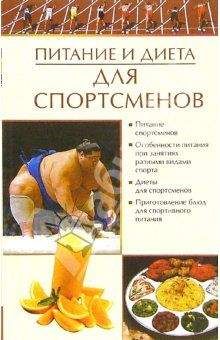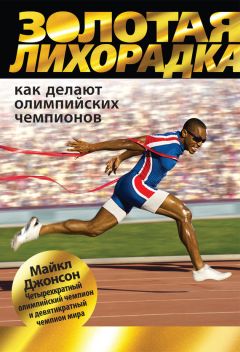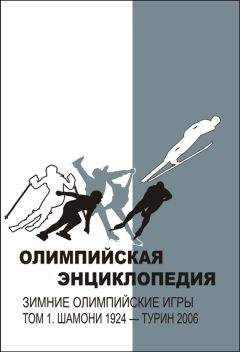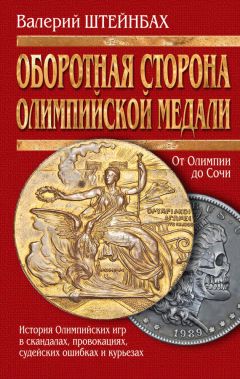Ознакомительная версия.
Anderson, O. German Study Confirms Major Shifts in Intensity Work Far Better Than Big Upswings in Mileage // Running Research News 12, no. 9 (1996): 1–5.
Anderson, O. The Search for the Perfect Intensity Distribution // Cycling Research News 1, no. 10 (2004): 1, 4–10.
Anderson, O. Things Your Parents Forgot to Tell You about Tapering // Running Research News 11, no. 7 (1995): 1–8.
Appell, H. J. et al. Supplementation of Vitamin E May Attenuate Skeletal Muscle Immobilization Atrophy // International Journal of Sports Medicine 18 (1997): 157–160.
Armsey, T. D., and Green, G. A. Nutrition Supplementation: Science vs. Hype // T he Physician and Sports Medicine 25, no. 6 (1997): 77–92.
Astrand, P. O., and Rohdahl, K. Textbook of Work Physiology. New York: McGraw-Hill, 1977.
Atwater, A. E. Gender Differences in Distance Running // Biomechanics of Distance Running / ed. P. R. Cavanagh. Champaign, IL: Human Kinetics, 1990.
Balaban, E. P. et al. The Frequency of Anemia and Iron Deficiency in the Runner // Medicine and Science in Sport and Exercise 21 (1989): 643–648.
Balsam, P. D. Creatine Supplementation Per Se Does Not Enhance Endurance Exercise Performance // Acta Physiologica Scandinavica 149, no. 4 (1993): 521–523.
Bemben, D. A. et al. Effects of Oral Contraceptives on Hormonal and Metabolic Responses during Exercise // Medicine and Science in Sport and Exercise 24, no. 4 (1992): 434–441.
Bernhardt, G. Training Plans for Multisport Athletes. Boulder, CO: VeloPress, 2000.
Billat, V. L. et al. Physical and Training Characteristics of Top-Class Marathon Runners // Medicine and Science in Sports and Exercise 33, no. 12 (2001): 2089–2097.
Blomstrand, E. et al. Administration of Branched Chain Amino Acids during Sustained Exercise – Effects on Performance and on Plasma Concentrations of Some Amino Acids // European Journal of Applied Physiology 63, no. 2 (1991): 83–88.
Bompa, T. From Childhood to Champion Athlete. Toronto, ON: Veritas Publishing, 1995.
Bompa, T. Periodization of Strength. Toronto, ON: Veritas Publishing, 1993.
Bompa, T. Physiological Intensity Values Employed to Plan Endurance Training // New Studies in Athletics 3, no. 4 (1988): 37–52.
Bompa, T. Theory and Methodology of Training. Dubuque, IA: Kendall/Hunt Publishing, 1994.
Bonen, A., and Belcastro, A. Comparison of Self-Selected Recovery Methods on Lactic Acid Removal Rates // Medicine and Science in Sports and Exercise 8 (1976): 176–178.
Borg, G. An Introduction to Borg’s RPE-Scale. Ithaca, NY: Movement Publications, 1985.
Bouchard, C., and Lortie, G. Heredity and Endurance Performance // Sports Medicine 1 (1984): 38–94.
Brenner, I. K. M. Infection in Athletes // Sports Medicine 17, no. 2 (1994): 86–107.
Broker, J. P., and Gregor, R. J. Cycling Biomechanics // High-Tech Cycling / ed. E. Burke. Champaign, IL: Human Kinetics, 1996.
Brown, C., and Wilmore, J. The Effects of Maximal Resistance Training on the Strength and Body Composition of Women Athletes // Medicine and Science in Sports and Exercise 6 (1974): 174–177.
Brunner, R., and Tabachnik, B. Soviet Training and Recovery Methods. Pleasant Hill, CA: Sport Focus Publishing, 1990.
Brzycki, M. Strength Testing – Predicting a One-Rep Max from Reps to Fatigue // Journal of Physical Education, Recreation and Dance 64 (1993): 88–90.
Budgett, R. Overtraining Syndrome // British Journal of Sports Medicine 24 (1990): 231–236.
Bull, S. J. Sports Psychology: A Self-Help Guide. Marlborough, UK: Crowood Press, 2000.
Bunt, J. C. et al. Sex and Training Differences in Human Growth Hormone Levels during Prolonged Exercise // Journal of Applied Physiology 61 (1986): 1796.
Burke, E. High-Tech Cycling. Champaign, IL: Human Kinetics, 1996.
Burke, E. Serious Cycling. Champaign, IL: Human Kinetics, 1995.
Burke, L. M., and Read, R. S. D. Dietary Supplements in Sport // Sports Medicine 15 (1993): 43–65.
Butts, N. K., Henry, B. A., and Mclean, D. Correlations between V02Max and Performance Times of Recreational Triathletes // Journal of Sports Medicine and Physical Fitness 31, no. 3 (1991): 339–344.
Cade, J. R. et al. Dietary Intervention and Training in Swimmers // European Journal of Applied Physiology 63 (1991): 210–215.
Cavanagh, P. R., and Sanderson, D. J. The Biomechanics of Cycling: Studies of the Pedaling Mechanics of Elite Pursuit Riders // Science of Cycling / ed. E. Burke. Champaign, IL: Human Kinetics, 1986.
Cavanagh, P. R. et al. A Biomechanical Comparison of Elite and Good Distance Runners // Annals of the New York Academy of Sciences 301 (1977): 328–345.
Cerra, F. B. et al. Branched-Chain Amino Acid Supplementation during Trekking at High Altitude // European Journal of Applied Physiology 65 (1984): 394–398.
Child, J. S. et al. Cardiac Hypertrophy and Function in Masters Endurance Runners and Sprinters // Journal of Applied Physiology 57 (1984): 170–181.
Clark. Red Meat: To Eat or Not to Eat // National Strength and Conditioning Association Journal 15 (1993): 71–72.
Clement, D. B. et al. Branched-Chain Metabolic Support: A Prospective, Randomized Double-Blind Trial in Surgical Stress // Annals of Surgery 199, no. 3 (1984): 286–291.
Cohen, J., and Gisolfi, C. V. Effects of Interval Training in Work-Heat Tolerance in Young Women // Medicine and Science in Sport and Exercise 14 (1982): 46–52.
Conley, D. L., and Krahenbuhl, G. Running Economy and Distance Running Performance of Highly Trained Athletes // Medicine and Science in Sports and Exercise 12, no. 5 (1980): 357–360.
Conley, D. L. et al. Following Steve Scott: Physiological Changes Accompanying Training // The Physician and Sports Medicine 12, no. 1 (1984): 103–106.
Cordain, L. Department of Exercise and Sport Science. Colorado State University, Fort Collins, CO (1998). Личное общение с автором.
Cordain, L. The Paleo Diet. New York: Wiley, 2002.
Cordain, L., and Friel, J. The Paleo Diet for Athletes. Emmaus, PA: Rodale, 2005.
Cordain, L., Gotshall, R. W., and Eaton, S. B. Evolutionary Aspects of Exercise // World Review of Nutrition and Dietetics 81 (1997): 49–60.
Costill, D. Predicting Athletic Potential: The Value of Laboratory Testing // Sports Medicine Digest 11, no. 11 (1989): 7.
Costill, D. et al. Adaptations to Swimming Training: Influence of Training Volume // Medicine and Science in Sports and Exercise 23 (1991): 371–377.
Costill, D. L. et al. Effects of Repeated Days of Intensified Training on Muscle Glycogen and Swimming Performance» // Medicine and Science in Sport and Exercise 20 (1988): 249–254.
Coyle, E. F. et al. Cycling Efficiency Is Related to the Percentage of Type I Muscle Fibers // Medicine and Science in Sports and Exercise 24 (1992): 782.
Cunningham, D. A. et al. Cardiovascular Response to Intervals and Continuous Training in Women // European Journal of Applied Physiology 41 (1979): 187–197.
Daniels, J. Daniels’ Running Formula. 2nd edition. Champaign, Human Cinetics, 2005.
Daniels, J. Physiological Characteristics of Champion Male Athletes // Research Quarterly 45 (1989): 342–348.
Daniels, J. et al. Interval Training and Performance // Sports Medicine 1 (1984): 327–334.
David, A. S. et al. Post-Viral Fatigue Syndrome: Time for a New Approach // British Medical Journal 296 (1988): 696–699.
Davis, J. M. Carbohydrates, Branched-Chain Amino Acids, and Performance – the Central Fatigue Hypothesis // International Journal of Sport Nutrition 5 (1995): S29-S38.
Deuster, P. A. et al. Nutritional Survey of Highly Trained Women Runners // American Journal of Clinical Nutrition 45 (1986): 954–962.
De Vries, H. A. Effects of Various Warm-up Procedures on 100-Yard Times of Competitive Swimmers // Research Quarterly 30 (1959): 11–20.
DiCarlo, L. J. et al. Peak Heart Rates during Maximal Running and Swimming: Implications for Exercise Prescription // International Journal of Sports Medicine 12 (1991): 309–312.
Dill, D. et al. A Longitudinal Study of 16 Champion Runners // Journal of Sports Medicine 7 (1967): 4–32.
Dimsdale, J. et al. Postexercise Peril: Plasma Catecholamines and Exercise // Journal of the American Medical Association 251 (1984): 630–632.
Doherty, M. The Effects of Caffeine on the Maximal Accumulated Oxygen Deficit and Short-Term Running Performance // International Journal of Sports Nutrition 8, no. 2 (1998): 95–104.
Dragan, I., and Stonescu, I. Organism Recovery Following Training. Bucharest, Romania: Sport-Turism, 1978.
Drinkwater, B. L. Women and Exercise: Physiological Aspects // Exercise and Sports Sciences Reviews 12 (1984): 21–51.
Drinkwater, B. L. et al. Bone Mineral Content of Amenorrheic and Eumenorrheic Athletes // New England Journal of Medicine 311 (1984): 277–281.
Driver, H. S. et al. Prolonged Endurance Exercise and Sleep Disruption // Medicine and Science in Sports and Exercise 26, no. 7 (1994): 903–907.
Droghetti, P. et al. Noninvasive Determination of the Anaerobic Threshold in Canoeing, Cross-Country Skiing, Cycling, Roller and Ice Skating, Rowing and Walking // European Journal of Applied Physiology 53 (1985): 299–303.
Dufaux, B. et al. Serum Ferritin, Transferrin, Haptoglobin, and Iron in Middle– and Long-Distance Runners, Elite Rowers, and Professional Racing Cyclists // International Journal of Sports Medicine 2 (1981): 43–46.
Dunbar, C. C. et al. The Validity of Regulating Exercise Intensity by Ratings of Perceived Exertion // Medicine and Science in Sports and Exercise 24 (1992): 94–99.
Dutto, D. J., and Cappaert, J. M. Biomechanical and Physiological Differences between Males and Females during Freestyle Swimming // Medicine and Science in Sports and Exercise 26, no. 5 (1994): 1098.
Eaton, S. B. Humans, Lipids, and Evolution // Lipids 27, no. 1 (1992): 814–820.
Eaton, S. В., and Konner, M. Paleolithic Nutrition: A Consideration of Its Nature and Current Implications // The New England Journal of Medicine 312, no. 5 (1985): 283–289.
Eaton, S. B., and Nelson, D. A. Calcium in Evolutionary Perspective // American Journal of Clinical Nutrition 54 (1991): 281S–287S.
Eaton, S. B., Shostak, M., and Konner, M. The Paleolithic Prescription. New York: Harper & Row, 1989.
Ekblom, B. Effect of Physical Training in Adolescent Boys // Journal of Applied Physiology 27 (1969): 350–353.
Elliott, R. The Competitive Edge. Mountain View, CA: TAFNEWS Press, 1991.
Ericsson, K. A., Krampe, R. T., and Heizmann, S. Can We Create Gifted People? // CIBA Foundation Symposium 178 (1993): 221–231.
Evans, M. Endurance Athlete’s Edge. Champaign, IL: Human Kinetics, 1997.
Evans, M. Triathlete’s Edge. Champaign, IL: Human Kinetics, 2003.
Evans, W. et al. Protein Metabolism and Endurance Exercise // The Physician and Sports Medicine 11, no. 7 (1983): 63–72.
Farber, H. W. et al. The Endurance Triathlon: Metabolic Changes after Each Event and during Recovery // Medicine and Science in Sports and Exercise 23, no. 8 (1991): 959–965.
Faria, I. E. Applied Physiology of Cycling // Sports Medicine 1 (1984): 187–204.
Farrell, P. A. et al. Enkephalins, Catecholamines, and Psychological Mood Alterations: Effects of Prolonged Exercise // Medicine and Science in Sports and Exercise 19 (1987): 347.
Female Endurance Athletes / ed. B. L. Drinkwater. Champaign, IL: Human Kinetics, 1986.
Fitzgerald, L. Exercise and the Immune System // Immunology Today 9, no. 11 (1988): 337–339.
Francis, K. T. et al. The Relationship between Anaerobic Threshold and Heart Rate Linearity during Cycle Ergometry // European Journal of Applied Physiology 59 (1989): 273–277.
Freeman, W. Peak When It Counts. Mountain View, CA: TAFNEWS Press, 1991.
Freuncl, B. J. et al. Glycerol Hyperhydration: Hormonal, Renal, and Vascular Fluid Responses // Journal of Applied Physiology 79 (1995): 2069–2077.
Friel, J. The Cyclist’s Training Bible. 4-th edition. Boulder: VeloPress, 2009.
Fry, R. W. et al. Biological Responses to Overload Training in Endurance Sports // European Journal of Applied Physiology 64, no. 5 (1992): 335–344.
Fry, R. W. et al. Overtraining in Athletes: An Update // Sports Medicine 12, no. 1 (1991): 32–65.
Fry, R. W. et al. Periodization and the Prevention of Overtraining // Canadian Journal of Sports Science 17 (1992): 241–248.
Gibbons, E. S. The Significance of Anaerobic Threshold in Exercise Prescription // Journal of Sports Medicine 27 (1987): 357–361.
Gibbons, T. P. et al. Physiological Responses in Elite Junior Triathletes during Field Testing // Medicine and Science in Sports and Exercise 28, no. 5 (1996): SA756.
Gleeson, M. Biochemical and Immunological Markers of Overtraining // Journal of Sports Science and Medicine 1 (2002): 31–41.
Goedecke, J. H. et al. Effects of Medium-Chain Triaclyglycerol Ingested with Carbohydrate on Metabolism and Exercise Performance // International Journal of Sports Nutrition 9, no. 1 (1999): 35–47.
Goforth, H. W. et al. Simultaneous Enhancement of Aerobic and Anaerobic Capacity // Medicine and Science in Sports and Exercise 26, no. 5 (1994): 171.
Ознакомительная версия.





